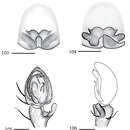Description
provided by Zookeys
Male:Color:carapace light tan-yellow, Slightly darker in cephalic region, dusky around edge; sternum pale yellow; chelicerae light brown with some dusky markings; maxillae dusky yellow-brown, lightening distally; labium pale yellow-brown; abdomen dorsally grey with lanceolate stripe with chevrons anteromedially, connecting to duskier lateral margins, one dot near the end of the abdomen, festoon present; ventrally pale yellow, no markings; legs light yellowish-tan, darkening distally, annulations hardly visible. Carapace: 0.89 times longer than broad; fovea longitudinal, broad, very shallow. Eyes:AER nearly straight; PER recurved; PME larger than AME, PLE largest, ALE smallest; eye diameters, AME 0.25, ALE 0.08, PME 0.28, PLE 0.35; interdistances AME-PME 0.08, PME-ALE 0.10, ALE-PLE 0.35. PME-PME 1.25. ALE-ALE 1.95; ocular quadrangle AME-AME 0.45, PLE-PLE 2.15; clypeus 0.05 high. Mouthparts:chelicerae with a few stout setae medially and anteriorly; maxillae longer than broad, with tuft of conspicuous setae distally; labium distally rounded. Sternum:as long as broad, posteriorly indented. Legs:leg I only slightly shorter than II and III; leg formula 2314; scopulae present on distal end of all 4 tarsi; tarsi I-IV with strong claw tufts; pr claw per foot slightly toothed; spination: leg I, Fm pr 1–1–1, d 1–1–1, rl 1–1–1; Ti pr 1–0–1, d 1–1–0, rl (R) 1–1–1 (L) 1–0–1, v 2–2–2–2; Mt pr 1–0–0, v 2–2, rl 1–0–0; leg II, Fm pr 1–1–1, d 1–1–1, rl 1–1–1; Ti pr 1–0–1, d 1–1–0, rl 1–0–1, v 2–2–2–2; Mt pr 1–1–0, rl 1–0–0, v 2–2; leg III, Fm pr 1–1–1, d 1–1–1, rl 1–1–1; Ti pr 1–0–1, d 0–1–0, rl 1–0–1, v 2–2–2; Mt pr 1–1–0, rl 1–0–0, v 2–2; leg IV, Fm pr 1–1–1, d 1–1–1, rl 0–1–1; Ti pr 1–0–1, v 2–2–0, rl 1–0–1; Mt pr 1–1–0, rl 1–0–0, v 2–2–0. Abdomen:without terminal setal tufts. Pedipalp:femur, spination d 0–1–4; cymbium triangular in ventral view, angled posterolaterally; basal cymbial process absent, scopulae scattered, denser toward tip; conductor somewhat hammer shaped to T-shaped, on short straight stalk originating anteromedially, pointed laterally, not extending beyond cymbium edge, left side connecting to bulb, forming circular space between two conductor connections; embolus short, beginning at 6 o'clock, ending at 11 o'clock, basally stout and 2 branched, narrowing distally, slender and slightly curved; MA wider at base, slightly sinuous, distally curved into single hook, MA originating at 3 o'clock, directed distally; RTA extending 1/5th the length of cymbium in ventral view, with 3 processes, lateral process large, curves away from cymbium, terminally rounded, middle apophysis very small, pointed, ventral apophysis curves ventrally then dorsally, widening, rounded distally (Figs 105–106).Dimensions:Total length 8.55. Carapace length 4.00, width4.50. Sternum length 1.65, width 1.65. Abdomen length 4.55, width 3.53. Pedipalp: Fm 0.90, Pt 0.30, Ti 0.40, Ta 0.75, total 2.35. Leg I: Fm 4.40, Pt 1.70, Ti 4.00, Mt 4.00, Ta 1.75, total 15.85. Leg II: Fm 5.00, Pt 1.70, Ti 4.60, Mt 4.50, Ta 1.65, total 17.45. Leg III: Fm 5.00, Pt 1.50, Ti 4.40, Mt 4.40, Ta 1.50, total 16.8.0 Leg IV: Fm 4.50, Pt 1.00, Ti 3.70, Mt 3.75, Ta 1.30, total 14.25.
Holotype female:Color:carapace red-brown, dusky medially and laterally; sternum orange-brown, darker around border; chelicerae red-brown, black medially to caudally; maxillae light orange-brown, lightening distally; labium orange-brown, lightening toward the distal edge; abdomen dorsally grey with lanceolate stripe with chevrons coming off near the top and center, connecting to duskier lateral edges, one dot near the end of the abdomen, festoon present; ventrally cream-colored, dark on laterally, caudally; legs orange-brown, annulations present, legs darkening distally, brown at metatarsi, tarsi. Carapace: 1.10 times longer than broad; fovea longitudinal, broad, very shallow. Eyes:AER nearly straight; PER slightly recurved; PME larger than AME, PLE largest, ALE smallest; eye diameters, AME 0.23, ALE 0.18, PME 0.28, PLE 0.35; interdistances AME-PME 0.08, PME-ALE 0.18, ALE-PLE 0.43. PME-PME 1.30. ALE-ALE 1.88; ocular quadrangle AME-AME 0.45, PLE-PLE 2.15; clypeus 0.07 high. Mouthparts:chelicerae with stout setae medially and anteriorly; maxillae longer than broad, with tuft of conspicuous setae distally; labium distally rounded. Sternum:1.11 times longer than broad, posteriorly indented Legs:leg I only slightly shorter than legs II, III and IV; leg formula 3241; scopulaepresent on all 4 tarsi and metatarsi and tibiae I and II; tarsi I-IV with strong claw tufts; prolateral claw per foot slightly toothed; spination: leg I, Fm pr 1–1–0, d 1–1–1, rl 0–1–1; Ti d 0, v 2–2–2; mt v 2–2; leg II, Fm pr 1–1–0, d 1–1–1, rl 0–1–1; Ti v 2–2–2; Mt v 2–2; leg III, Fm pr 1–0–0, d 1–1–1, rl 0; Ti v 2–2–0; Mt v 2–0; leg IV, Fm pr 1–0–0, d 1–1–1, rl 0–0–1; Ti v 1–1; Mt v 2–1. Abdomen:with terminal setal tufts. Pedipalp:claw with 5 teeth. Epigyne:sinuous opening located medially on epigynal plate, epigynal pockets present, genital openings located behind sinuous margin; internally, ducts expand posteriorly and laterally, cylindrical, though not coiled, posterodorsal fold present, covering internal ducts medially (Figs 103–104).Dimensions:Total length 8.85. Carapace length 4.05, width 4.40. Sternum length 2.00, width 1.80. Abdomen length 4.80, width 3.68 Pedipalp: Fm 1.00, Pt 0.50, Ti 0.50, Ta 1.00, total 3.00. Leg I: Fm 4.00, Pt 1.75, Ti 3.00, Mt 3.00, Ta 1.00, total 12.75. Leg II: Fm 4.00, Pt 2.00, Ti 3.50, Mt 3.00, Ta 1.00, total 13.50. Leg III: Fm 5.00, Pt 1.75, Ti 4.00, Mt 3.00, Ta 1.00, total 14.75. Leg IV: Fm 4.60, Pt 1.00, Ti 3.50, Mt 3.00, Ta 1.00, total 13.10.
- bibliographic citation
- Crews S (2011) A revision of the spider genus Selenops Latreille, 1819 (Arachnida, Araneae, Selenopidae) in North America, Central America and the Caribbean ZooKeys 105: 1–182
- author
- Sarah C. Crews

